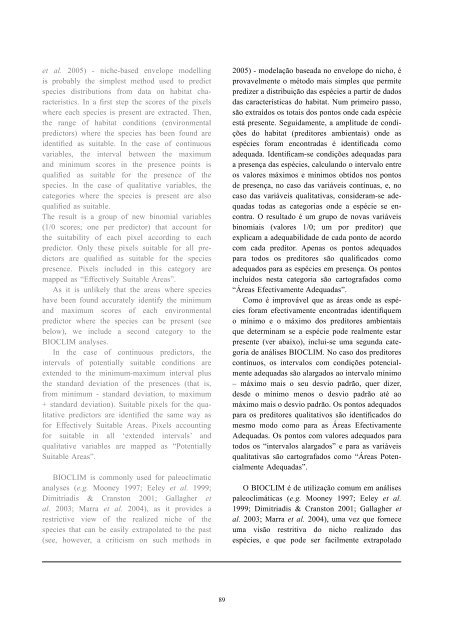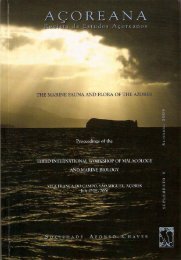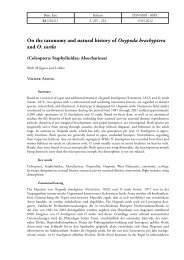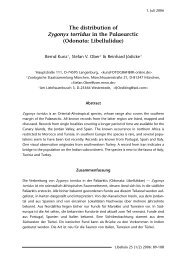(eds.) (2005). - Portal da Biodiversidade dos Açores - Universidade ...
(eds.) (2005). - Portal da Biodiversidade dos Açores - Universidade ...
(eds.) (2005). - Portal da Biodiversidade dos Açores - Universidade ...
Create successful ePaper yourself
Turn your PDF publications into a flip-book with our unique Google optimized e-Paper software.
et al. <strong>2005</strong>) - niche-based envelope modelling<br />
is probably the simplest method used to predict<br />
species distributions from <strong>da</strong>ta on habitat characteristics.<br />
In a first step the scores of the pixels<br />
where each species is present are extracted. Then,<br />
the range of habitat conditions (environmental<br />
predictors) where the species has been found are<br />
identified as suitable. In the case of continuous<br />
variables, the interval between the maximum<br />
and minimum scores in the presence points is<br />
qualified as suitable for the presence of the<br />
species. In the case of qualitative variables, the<br />
categories where the species is present are also<br />
qualified as suitable.<br />
The result is a group of new binomial variables<br />
(1/0 scores; one per predictor) that account for<br />
the suitability of each pixel according to each<br />
predictor. Only these pixels suitable for all predictors<br />
are qualified as suitable for the species<br />
presence. Pixels included in this category are<br />
mapped as “Effectively Suitable Areas”.<br />
As it is unlikely that the areas where species<br />
have been found accurately identify the minimum<br />
and maximum scores of each environmental<br />
predictor where the species can be present (see<br />
below), we include a second category to the<br />
BIOCLIM analyses.<br />
In the case of continuous predictors, the<br />
intervals of potentially suitable conditions are<br />
extended to the minimum-maximum interval plus<br />
the stan<strong>da</strong>rd deviation of the presences (that is,<br />
from minimum - stan<strong>da</strong>rd deviation, to maximum<br />
+ stan<strong>da</strong>rd deviation). Suitable pixels for the qualitative<br />
predictors are identified the same way as<br />
for Effectively Suitable Areas. Pixels accounting<br />
for suitable in all ‘extended intervals’ and<br />
qualitative variables are mapped as “Potentially<br />
Suitable Areas”.<br />
BIOCLIM is commonly used for paleoclimatic<br />
analyses (e.g. Mooney 1997; Eeley et al. 1999;<br />
Dimitriadis & Cranston 2001; Gallagher et<br />
al. 2003; Marra et al. 2004), as it provides a<br />
restrictive view of the realized niche of the<br />
species that can be easily extrapolated to the past<br />
(see, however, a criticism on such methods in<br />
89<br />
<strong>2005</strong>) - modelação basea<strong>da</strong> no envelope do nicho, é<br />
provavelmente o método mais simples que permite<br />
predizer a distribuição <strong>da</strong>s espécies a partir de <strong>da</strong><strong>dos</strong><br />
<strong>da</strong>s características do habitat. Num primeiro passo,<br />
são extraí<strong>dos</strong> os totais <strong>dos</strong> pontos onde ca<strong>da</strong> espécie<br />
está presente. Segui<strong>da</strong>mente, a amplitude de condições<br />
do habitat (preditores ambientais) onde as<br />
espécies foram encontra<strong>da</strong>s é identifica<strong>da</strong> como<br />
adequa<strong>da</strong>. Identificam-se condições adequa<strong>da</strong>s para<br />
a presença <strong>da</strong>s espécies, calculando o intervalo entre<br />
os valores máximos e mínimos obti<strong>dos</strong> nos pontos<br />
de presença, no caso <strong>da</strong>s variáveis contínuas, e, no<br />
caso <strong>da</strong>s variáveis qualitativas, consideram-se adequa<strong>da</strong>s<br />
to<strong>da</strong>s as categorias onde a espécie se encontra.<br />
O resultado é um grupo de novas variáveis<br />
binomiais (valores 1/0; um por preditor) que<br />
explicam a adequabili<strong>da</strong>de de ca<strong>da</strong> ponto de acordo<br />
com ca<strong>da</strong> preditor. Apenas os pontos adequa<strong>dos</strong><br />
para to<strong>dos</strong> os preditores são qualifica<strong>dos</strong> como<br />
adequa<strong>dos</strong> para as espécies em presença. Os pontos<br />
incluí<strong>dos</strong> nesta categoria são cartografa<strong>dos</strong> como<br />
“Áreas Efectivamente Adequa<strong>da</strong>s”.<br />
Como é improvável que as áreas onde as espécies<br />
foram efectivamente encontra<strong>da</strong>s identifiquem<br />
o mínimo e o máximo <strong>dos</strong> preditores ambientais<br />
que determinam se a espécie pode realmente estar<br />
presente (ver abaixo), inclui-se uma segun<strong>da</strong> categoria<br />
de análises BIOCLIM. No caso <strong>dos</strong> preditores<br />
contínuos, os intervalos com condições potencialmente<br />
adequa<strong>da</strong>s são alarga<strong>dos</strong> ao intervalo mínimo<br />
– máximo mais o seu desvio padrão, quer dizer,<br />
desde o mínimo menos o desvio padrão até ao<br />
máximo mais o desvio padrão. Os pontos adequa<strong>dos</strong><br />
para os preditores qualitativos são identifica<strong>dos</strong> do<br />
mesmo modo como para as Áreas Efectivamente<br />
Adequa<strong>da</strong>s. Os pontos com valores adequa<strong>dos</strong> para<br />
to<strong>dos</strong> os “intervalos alarga<strong>dos</strong>” e para as variáveis<br />
qualitativas são cartografa<strong>dos</strong> como “Áreas Potencialmente<br />
Adequa<strong>da</strong>s”.<br />
O BIOCLIM é de utilização comum em análises<br />
paleoclimáticas (e.g. Mooney 1997; Eeley et al.<br />
1999; Dimitriadis & Cranston 2001; Gallagher et<br />
al. 2003; Marra et al. 2004), uma vez que fornece<br />
uma visão restritiva do nicho realizado <strong>da</strong>s<br />
espécies, e que pode ser facilmente extrapolado

















